African finches are small, colorful birds found all over Africa. They belong to the Estrildidae family, also known as the waxbill family. These birds are famous for their bright colors, cheerful songs, and lively behavior.
What African Finches Are Like
- Size and Appearance: African finches are generally small to medium-sized, between 9 and 15 cm long. They come in bright colors like red, blue, green, and orange, and many have unique patterns or markings.
- Habitat: They live in many types of environments, such as savannas, grasslands, forests, and wetlands. Some like open areas with lots of plants, while others prefer drier places or areas near water.
- Diet: They mainly eat seeds, which they crack open with their strong beaks. Some also eat small insects and bugs, especially when they are breeding and need extra protein.
- Behavior: African finches are usually social and are often seen in groups, especially when they are not breeding. They are active foragers and have melodious songs that they use to communicate and attract mates.
- Nesting: They build nests in different places depending on the species, such as in bushes, grasses, or tree branches. Their nests are usually well-made and can be quite elaborate.
- Breeding: Most African finches breed during the wet season when there is plenty of food. They lay several eggs, which both parents take turns incubating. The chicks are born naked and need their parents to keep them warm and feed them.
20 African finches
| # | Finch Name | Description |
|---|---|---|
| 1 | Red-cheeked Cordon-bleu | Blue with distinctive red cheek patches. |
| 2 | Lavender Waxbill | Soft lavender color with gray underparts. |
| 3 | Green-winged Pytilia | Green wings and a striking red face. |
| 4 | Red-billed Firefinch | Mostly red with a brownish tinge. |
| 5 | Cut-throat Finch | Brown body with a bold red stripe across the throat. |
| 6 | Zebra Waxbill | Red with black and white stripes. |
| 7 | African Firefinch | Deep red body with brown wings. |
| 8 | Bronze Mannikin | Brownish body with a white belly. |
| 9 | Orange-breasted Waxbill | Bright orange and black plumage. |
| 10 | Crimson Seedcracker | Vivid red and black coloration. |
| 11 | Blue-breasted Cordon-bleu | Bright blue body with pale underparts. |
| 12 | Black-faced Waxbill | Gray body with a distinct black face. |
| 13 | Gold-breasted Waxbill | Golden-yellow body with a black belly. |
| 14 | Quail Finch | Brown with white spots, resembling a quail. |
| 15 | Jameson’s Firefinch | Bright red with slightly darker wings. |
| 16 | African Silverbill | Brownish body with a shiny silver beak. |
| 17 | Purple Grenadier | Stunning purple body with red face markings. |
| 18 | Red-headed Finch | Brown body with a red head and breast. |
| 19 | Yellow-fronted Canary | Bright yellow body with a green back and wings. |
| 20 | Peters’s Twinspot | Brown with white spots and a red rump. |
Details
1. Red-cheeked Cordon-bleu
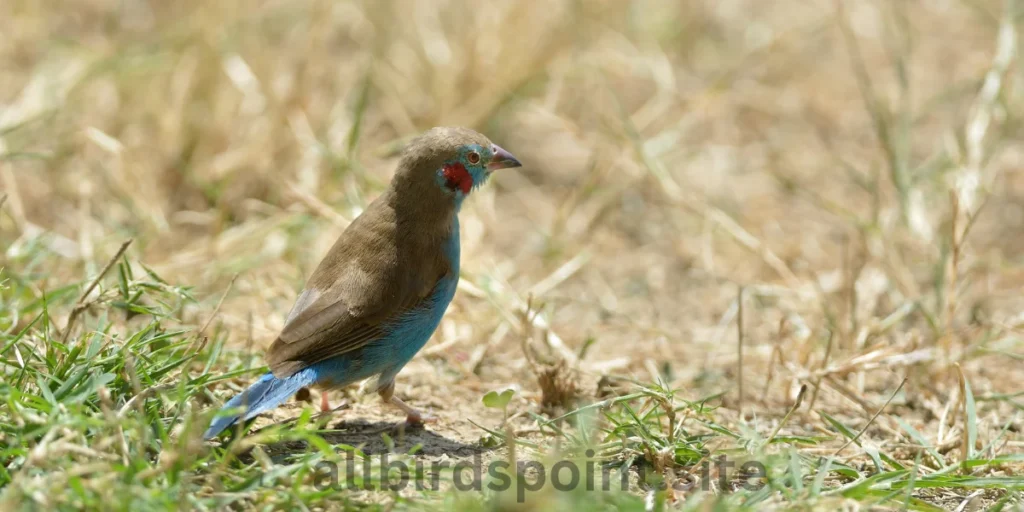
Description: The Red-cheeked Cordon-bleu is a visually stunning African finch known for its vibrant blue plumage and distinctive red cheek patches. This bird measures around 12-13 cm in length and is commonly found in the grasslands and savannas of Sub-Saharan Africa. Its striking coloration and melodious song make it a favorite among bird watchers. The Red-cheeked Cordon-bleu primarily feeds on seeds and occasionally small insects, which it forages for in its open habitat.
| Attribute | Details |
|---|---|
| Size | 12-13 cm |
| Habitat | Grasslands and savannas in Sub-Saharan Africa |
| Diet | Seeds, small insects |
| Behavior | Melodious song during courtship |
| Lifespan | Around 5-7 years in the wild |
2. Lavender Waxbill
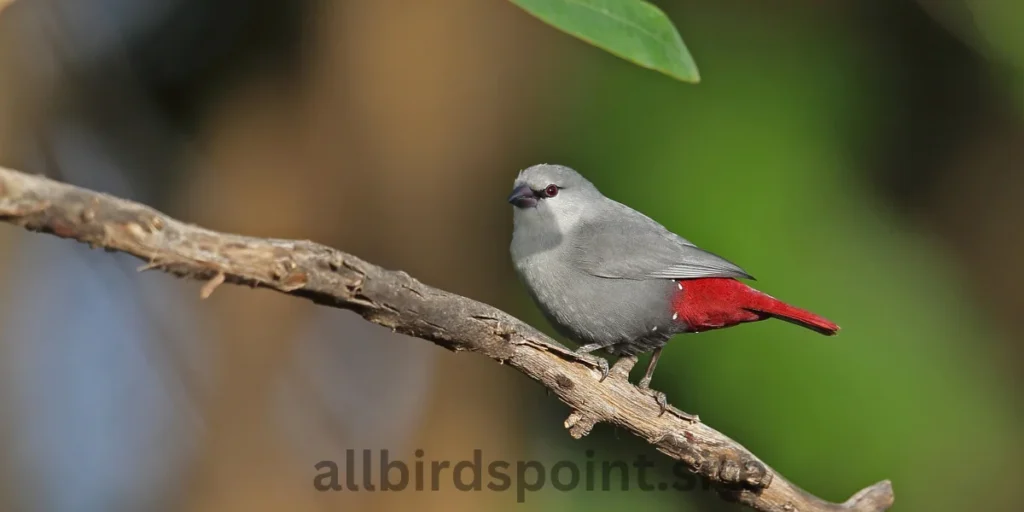
Description: The Lavender Waxbill is a delicate bird with a soft lavender color that extends over most of its body, contrasted by gray underparts. Measuring about 10-12 cm in length, it inhabits tropical forests in Africa. Its diet consists mainly of seeds, and it is often seen foraging in pairs or small groups. The Lavender Waxbill’s gentle calls and elegant appearance make it a beloved species among bird enthusiasts.
| Attribute | Details |
|---|---|
| Size | 10-12 cm |
| Habitat | Tropical forests in Africa |
| Diet | Seeds |
| Behavior | Forages in pairs or small groups |
| Lifespan | Around 5 years in the wild |
3. Green-winged Pytilia

Description: The Green-winged Pytilia is renowned for its vibrant green wings and bright red face. This bird, measuring approximately 12-14 cm long, is commonly found in woodlands and savannas across Africa. It feeds primarily on seeds but also consumes small insects. The Green-winged Pytilia is social, often seen in small flocks, and its vivid coloration and lively behavior make it a joy to observe.
| Attribute | Details |
|---|---|
| Size | 12-14 cm |
| Habitat | Woodlands and savannas in Africa |
| Diet | Seeds, small insects |
| Behavior | Social, seen in small flocks |
| Lifespan | Around 5-6 years in the wild |
4. Red-billed Firefinch

Description: The Red-billed Firefinch is a small bird with mostly red plumage and a subtle brownish tinge on its wings. It is found in grasslands and near water sources throughout Africa. This species measures about 10-11 cm long and feeds on seeds. Known for its calm demeanor and soft song, the Red-billed Firefinch is often observed in pairs or small groups, adding color and charm to its habitat.
| Attribute | Details |
|---|---|
| Size | 10-11 cm |
| Habitat | Grasslands and near water sources in Africa |
| Diet | Seeds |
| Behavior | Calm demeanor, soft song |
| Lifespan | Around 5-7 years in the wild |
5. Cut-throat Finch
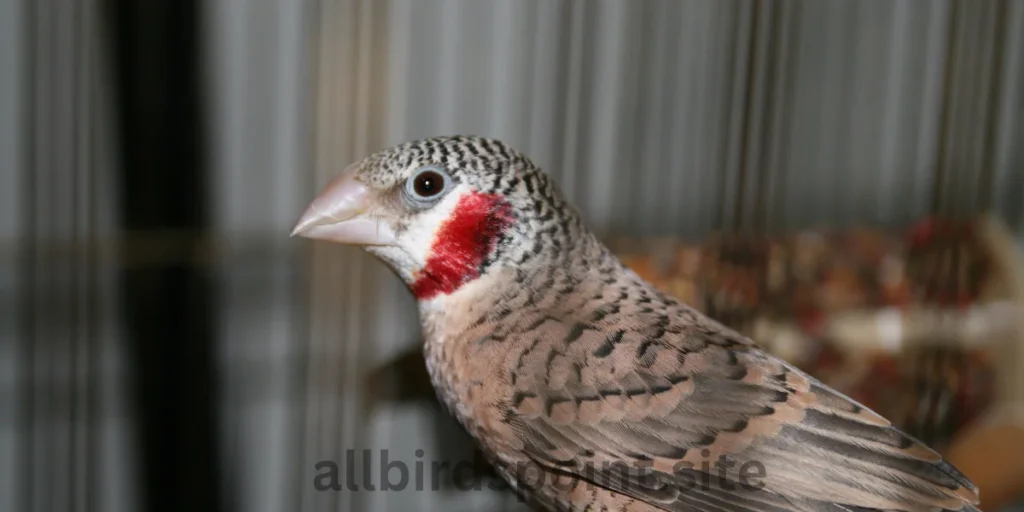
Description: The Cut-throat Finch is easily recognized by the bold red stripe across its throat, contrasting with its brown body. This distinctive coloration makes it stand out among other finches. Found in savannas and grasslands across Africa, this bird measures about 12-14 cm long and primarily feeds on seeds and insects. It is known for its strong social bonds and is often seen in large flocks.
| Attribute | Details |
|---|---|
| Size | 12-14 cm |
| Habitat | Savannas and grasslands in Africa |
| Diet | Seeds, insects |
| Behavior | Social, seen in large flocks |
| Lifespan | Around 5-6 years in the wild |
6. Zebra Waxbill
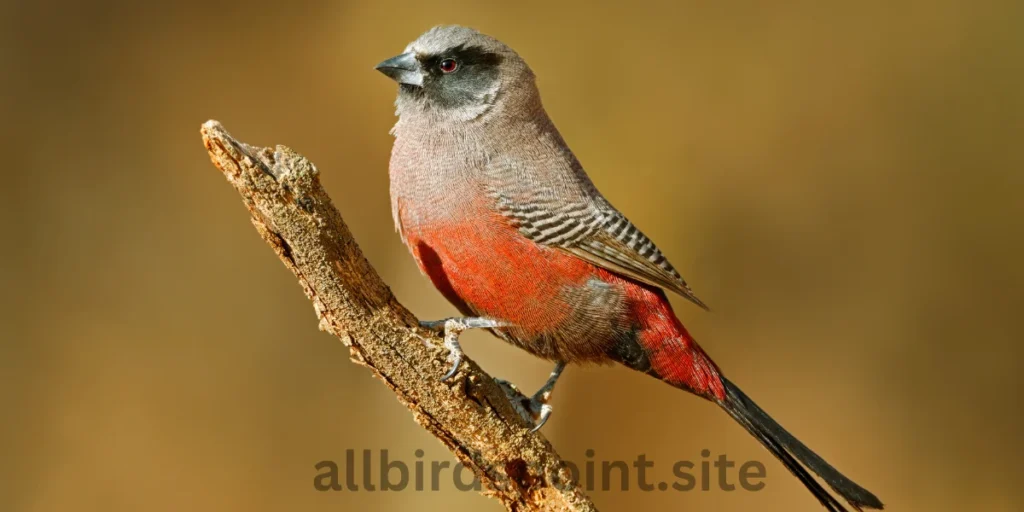
Description: The Zebra Waxbill is a small bird with striking black and white stripes, resembling a zebra’s pattern. It is found in wetlands and grasslands in Africa, measuring about 10-11 cm long. This species primarily feeds on seeds and is known for its lively behavior and cheerful calls. The Zebra Waxbill’s unique appearance and social nature make it a popular bird among enthusiasts.
| Attribute | Details |
|---|---|
| Size | 10-11 cm |
| Habitat | Wetlands and grasslands in Africa |
| Diet | Seeds |
| Behavior | Lively, cheerful calls, seen in flocks |
| Lifespan | Around 4-5 years in the wild |
7. African Firefinch

Description: The African Firefinch is a small bird with a deep red body and brownish wings. It inhabits the edges of forests and savannas across Africa, measuring about 10-11 cm in length. This bird feeds on a variety of seeds and is often seen foraging on the ground. Although somewhat shy, the African Firefinch’s vibrant plumage makes it a standout species in its habitat.
| Attribute | Details |
|---|---|
| Size | 10-11 cm |
| Habitat | Forest edges and savannas in Africa |
| Diet | Seeds |
| Behavior | Shy, vibrant colors |
| Lifespan | Around 5 years in the wild |
8. Bronze Mannikin

Description: The Bronze Mannikin is a small bird with a brownish body and a white belly. It is found in forests and grasslands throughout Africa, measuring about 10-11 cm long. This species primarily feeds on seeds and is known for its calm demeanor. The Bronze Mannikin is highly social, often seen in large flocks, and is a common and tranquil presence in its native habitats.
| Attribute | Details |
|---|---|
| Size | 10-11 cm |
| Habitat | Forests and grasslands in Africa |
| Diet | Seeds |
| Behavior | Calm, seen in large flocks |
| Lifespan | Around 5 years in the wild |
9. Orange-breasted Waxbill
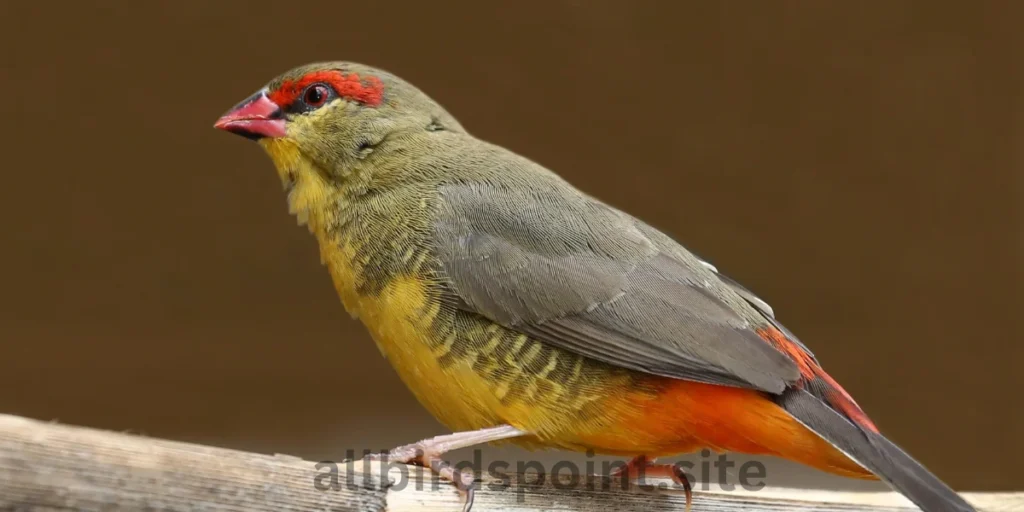
Description: The Orange-breasted Waxbill is a small bird with bright orange and black plumage. It is found in grasslands and wetlands across Africa, measuring about 9-10 cm long. This bird primarily feeds on seeds and is often seen foraging in pairs or small groups. Its vibrant colors and energetic behavior make it a favorite among bird watchers.
| Attribute | Details |
|---|---|
| Size | 9-10 cm |
| Habitat | Grasslands and wetlands in Africa |
| Diet | Seeds |
| Behavior | Forages in pairs or small groups |
| Lifespan | Around 4-5 years in the wild |
10. Crimson Seedcracker

Description: The Crimson Seedcracker is a striking bird with vivid red and black coloration. It is found in grasslands and wetlands across Africa, measuring approximately 11-13 cm long. Known for its powerful beak, the Crimson Seedcracker uses this feature to crack open hard seeds. Its bold colors and active behavior make it an interesting species to observe.
| Attribute | Details |
|---|---|
| Size | 11-13 cm |
| Habitat | Grasslands and wetlands in Africa |
| Diet | Seeds, insects |
| Behavior | Uses powerful beaks to crack seeds |
| Lifespan | Around 5-6 years in the wild |
11. Blue-breasted Cordon-bleu

Description: The Blue-breasted Cordon-bleu is an exquisite bird with bright blue plumage and pale underparts. Native to woodlands and savannas across Africa, it measures about 12-13 cm long. The diet of this bird includes seeds and small insects. Known for its gentle nature and melodious songs, particularly during mating season, the Blue-breasted Cordon-bleu is a delight to observe.
| Attribute | Details |
|---|---|
| Size | 12-13 cm |
| Habitat | Woodlands and savannas in Africa |
| Diet | Seeds, small insects |
| Behavior | Gentle nature, soft songs |
| Lifespan | Around 5 years in the wild |
12. Black-faced Waxbill

Description: The Black-faced Waxbill is characterized by its gray body and distinct black face. This small bird, measuring about 11-13 cm long, is found in dry savannas and scrublands across Africa. Its diet consists mainly of seeds, and it is often seen in small flocks. The Black-faced Waxbill’s unique appearance and social behavior make it an intriguing species to study.
| Attribute | Details |
|---|---|
| Size | 11-13 cm |
| Habitat | Dry savannas and scrublands in Africa |
| Diet | Seeds |
| Behavior | Social, seen in small flocks |
| Lifespan | Around 4-5 years in the wild |
13. Gold-breasted Waxbill
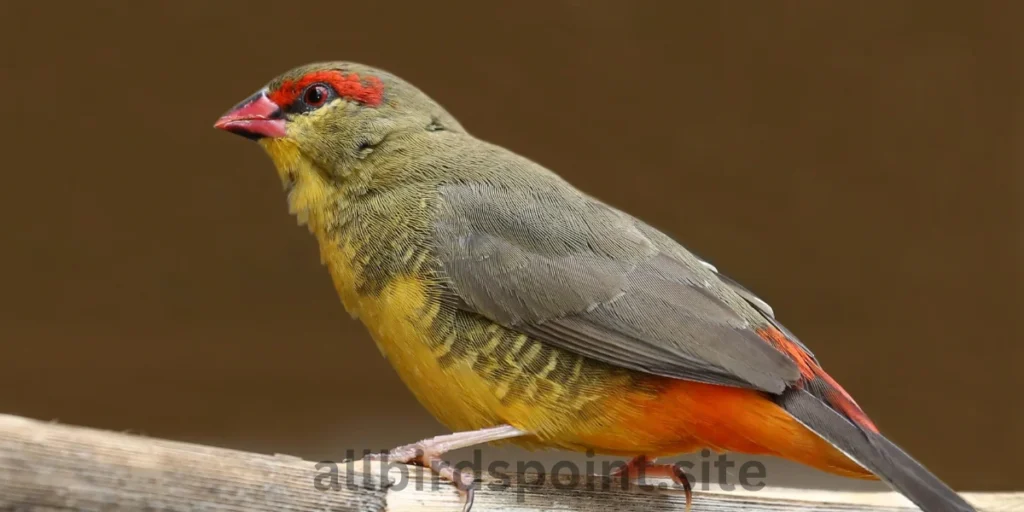
Description: The Gold-breasted Waxbill is a small bird with a brilliant golden-yellow body and a contrasting black belly. It is commonly found in grasslands and wetlands in Africa, measuring about 9-10 cm long. Its diet includes a variety of seeds, and it is often observed foraging in small groups. The Gold-breasted Waxbill’s bright colors and active demeanor make it a popular species among bird watchers.
| Attribute | Details |
|---|---|
| Size | 9-10 cm |
| Habitat | Grasslands and wetlands in Africa |
| Diet | Seeds |
| Behavior | Active, seen in small groups |
| Lifespan | Around 4-5 years in the wild |
14. Quail Finch
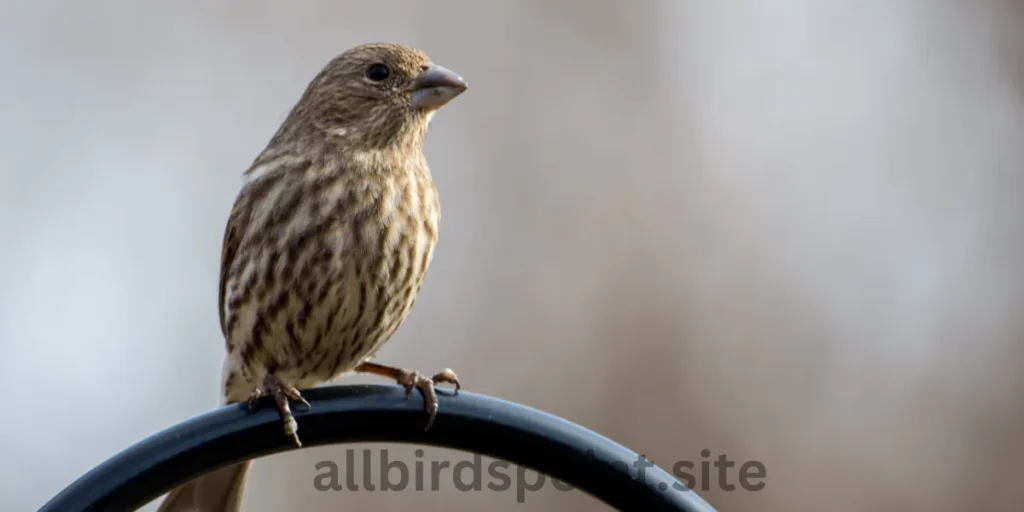
Description: The Quail Finch is a small bird with brown plumage adorned with white spots, giving it a quail-like appearance. It is found in grasslands and wetlands across Africa, measuring about 9-11 cm long. This bird primarily feeds on seeds and small insects and is often seen foraging on the ground in small groups. Its distinctive appearance and behavior make it a fascinating species to observe.
| Attribute | Details |
|---|---|
| Size | 9-11 cm |
| Habitat | Grasslands and wetlands in Africa |
| Diet | Seeds, small insects |
| Behavior | Ground-dwelling, forages in small groups |
| Lifespan | Around 4-5 years in the wild |
15. Jameson’s Firefinch
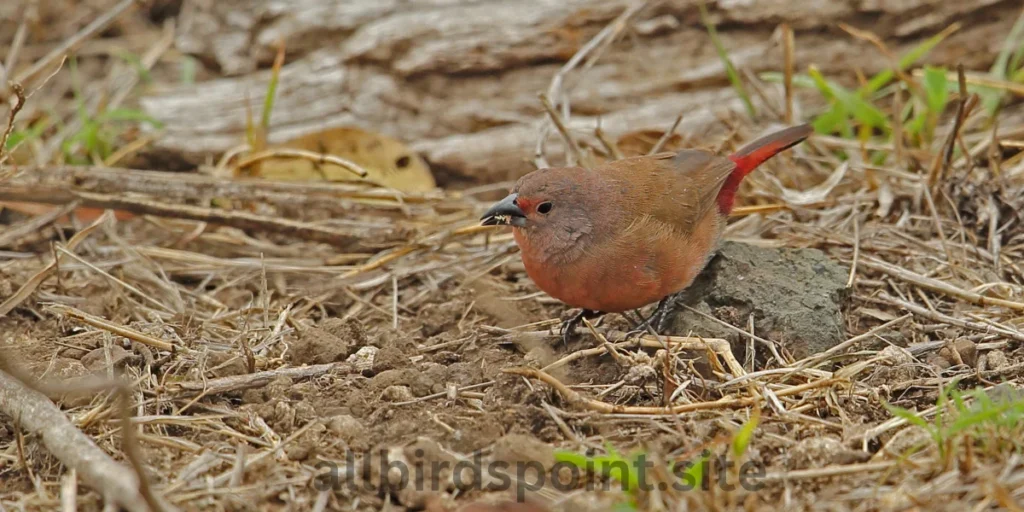
Description: Jameson’s Firefinch is a bright red bird with slightly darker wings. It is commonly found in grasslands and near water sources in Africa, measuring about 10-11 cm long. This bird primarily feeds on seeds and is often seen in pairs or small flocks. Known for its vivid colors and soft songs, Jameson’s Firefinch is a favorite among bird enthusiasts.
| Attribute | Details |
|---|---|
| Size | 10-11 cm |
| Habitat | Grasslands and near water sources in Africa |
| Diet | Seeds |
| Behavior | Social, often seen in pairs or small flocks |
| Lifespan | Around 5-6 years in the wild |
16. African Silverbill
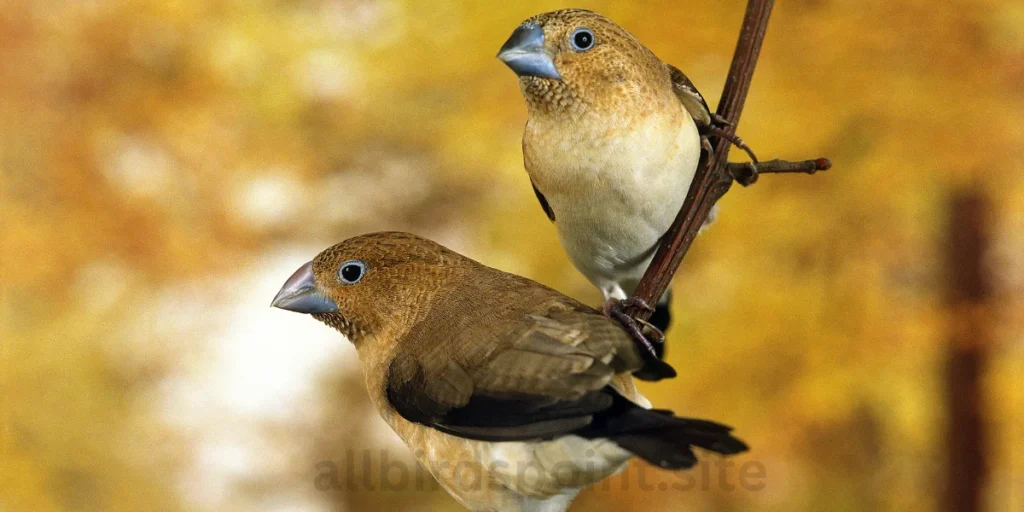
Description: The African Silverbill is a small bird with a brownish body and a shiny silver beak. It is found in dry savannas and scrublands across Africa, measuring about 10-12 cm long. This bird primarily feeds on seeds and is known for its social nature, often seen in large flocks. Its calm demeanor and distinctive beak make it a common and noteworthy species in its habitat.
| Attribute | Details |
|---|---|
| Size | 10-12 cm |
| Habitat | Dry savannas and scrublands in Africa |
| Diet | Seeds |
| Behavior | Social, seen in large flocks |
| Lifespan | Around 5 years in the wild |
17. Purple Grenadier
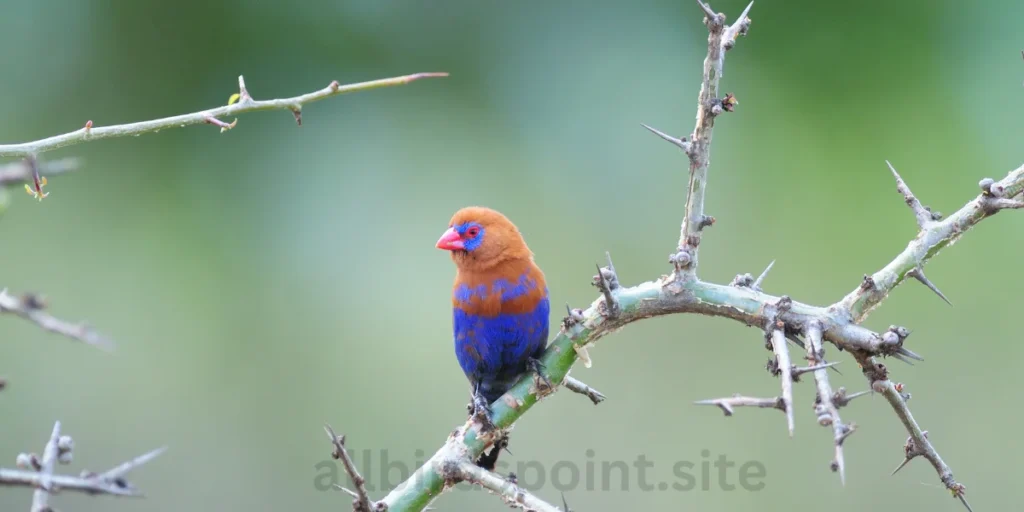
Description: The Purple Grenadier is a stunning bird with a striking purple body and red face markings. Native to dry savannas and scrublands in Africa, it measures about 13-14 cm long. This bird feeds on seeds and small insects and is known for its vibrant colors and active behavior. The Purple Grenadier is a favorite among bird watchers for its spectacular appearance and energetic nature.
| Attribute | Details |
|---|---|
| Size | 13-14 cm |
| Habitat | Dry savannas and scrublands in Africa |
| Diet | Seeds, small insects |
| Behavior | Active, lively |
| Lifespan | Around 5-6 years in the wild |
18. Red-headed Finch
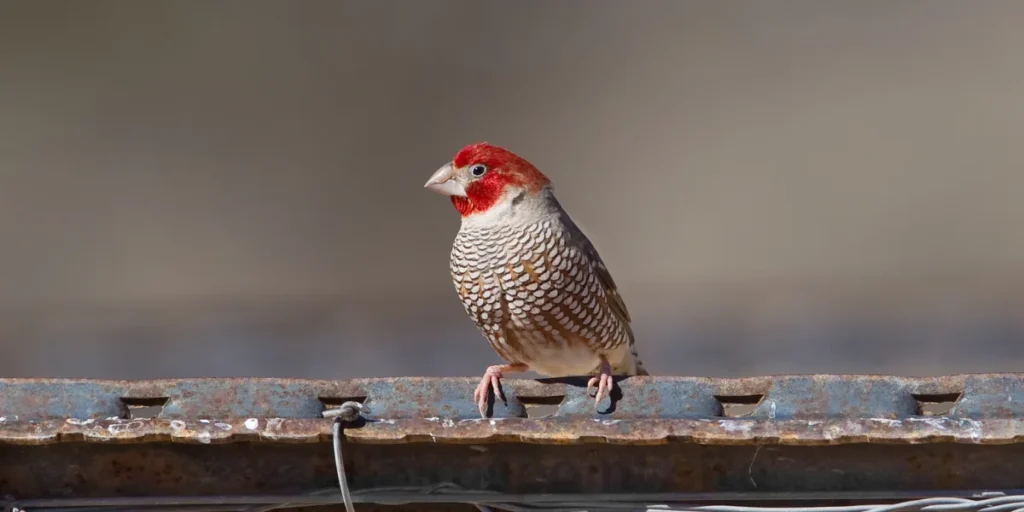
Description: The Red-headed Finch is a small bird with a distinctive red head and breast, contrasting with its brown body. Found in grasslands and savannas across Africa, it measures about 12-13 cm long. This bird primarily feeds on seeds and is often seen in pairs or small flocks. Its unique coloration and lively behavior make it an intriguing species to observe.
| Attribute | Details |
|---|---|
| Size | 12-13 cm |
| Habitat | Grasslands and savannas in Africa |
| Diet | Seeds |
| Behavior | Social, seen in pairs or small flocks |
| Lifespan | Around 5-6 years in the wild |
19. Yellow-fronted Canary

Description: The Yellow-fronted Canary is a bright yellow bird with a green back and wings. It is commonly found in open woodlands and grasslands across Africa, measuring about 12-13 cm long. This bird feeds on seeds and small insects and is known for its cheerful songs and active behavior. The Yellow-fronted Canary’s vivid coloration and lively presence make it a favorite among bird enthusiasts.
| Attribute | Details |
|---|---|
| Size | 12-13 cm |
| Habitat | Open woodlands and grasslands in Africa |
| Diet | Seeds, small insects |
| Behavior | Cheerful songs, active behavior |
| Lifespan | Around 5 years in the wild |
20. Peters’s Twinspot
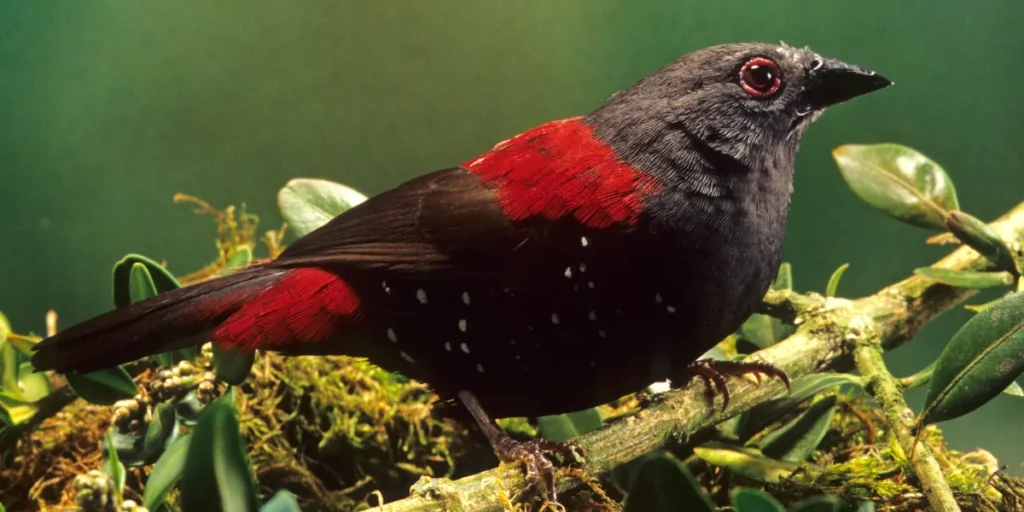
Description: Peters’s Twinspot is a small bird with a brown body, adorned with white spots and a red rump. It is found in grasslands and savannas across Africa, measuring about 11-12 cm long. This bird primarily feeds on seeds and is often seen foraging on the ground in pairs or small groups. Its unique appearance and shy nature make it a fascinating species to observe in its natural habitat.
| Attribute | Details |
|---|---|
| Size | 11-12 cm |
| Habitat | Grasslands and savannas in Africa |
| Diet | Seeds |
| Behavior | Shy, forages on the ground in pairs or small groups |
| Lifespan | Around 4-5 years in the wild |
FAQs About African Finches
1. What are African finches?
African finches are small, colorful birds from Africa, known for their bright plumage and lively behavior. They belong to the Estrildidae family.
2. What do African finches look like?
They are small to medium-sized, ranging from 9 to 15 cm long. They often have bright colors like red, blue, green, and orange, and many have unique patterns.
3. Where do African finches live?
They can be found in various habitats across Africa, including savannas, grasslands, forests, and wetlands.
4. What do African finches eat?
Their diet mainly consists of seeds, but they also eat small insects, especially during breeding season.
5. How do African finches behave?
They are social birds, often seen in flocks. They are active foragers and have melodious songs used for communication and attracting mates.
6. How do African finches build their nests?
They build nests in shrubs, grasses, or tree branches, and their nests are usually well-constructed.
7. When do African finches breed?
Most breed during the wet season when food is plentiful. Both parents incubate the eggs and care for the chicks.
Conclusion
African finches are a diverse and captivating group of birds that bring color and life to the landscapes
